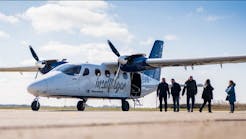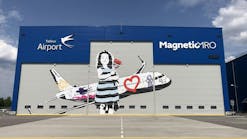Propellers are subject to wear, fatigue, corrosion and erosion, all of which can lead to failure if not kept in check.
Hartzell Propeller Design, Safety, and Maintenance
By Mike Disbrow
May-June 1998
Propellers seem to be one of the most visible and yet least respected components on the airplane. They lead a very difficult life, as they are blasted in operation by sand, rain, hail, etc., and are subjected to huge temperature extremes, all the while absorbing centrifugal loads of 10 to 20 tons per blade and punishing vibrational stresses induced by the engine and oncoming air stream. For all of this punishment, they are extremely reliable devices. Yet, like all mechanical components, they are subject to wear, fatigue, corrosion, and erosion, all of which can lead to failure if not kept in check. The failure of a propeller is usually a dramatic event. It does not simply result in a loss of thrust, as in an engine failure. If even a small portion of the propeller blade is lost, the resulting imbalance may tear the engine from the aircraft, making the aircraft uncontrollable.
A failure of the blade retention system is what motivated Hartzell to issue Service Bulletin 217, which led to FAA Airworthiness Directive (AD) 97-18-02. This bulletin and AD affects most of the propellers Hartzell produced in the 1950s and early 1960s and requires repetitive inspections of the blade retention system components. Before launching into a discussion of this issue, it would be helpful to provide a brief description of the construction of Hartzell propellers.
Propeller Design
The constant speed propeller consists of three major subcomponents:
blades, hub assembly, and spinner assembly.
The blades are what converts power into thrust. They are complex airfoils designed to optimize the performance of the aircraft over the broadest range of design criteria. Much of this design process is an exercise in compromise between the competing factors of takeoff/climb performance, cruise performance, noise, and ground clearance. Improvement in one of these areas may result in the degradation of another. At Hartzell, these designs are created using powerful computer programs to create the optimal combination of airfoil, twist distribution, and planform (shape).
The result is that most modern propellers are highly efficient (85 percent plus) at converting power into thrust. Blades also have to undergo a vibrational stress survey to ensure compatibility with the engine and airframe. Most propeller blades are made from a fatigue resistant aluminum alloy; however, many large propellers (greater than 1,500 shp) are being made from structural composite material (Kevlar or graphite). Composite blades are costly to manufacture, but extremely lightweight. This trade-off makes them advantageous only for large propellers and specialized applications.
The hub assembly is designed to contain the blades and the pitch change mechanism. Hartzell has two basic hub designs that are most commonly distinguished by their basic material: steel or aluminum. The steel hub design dates back to 1946. This design consists of a steel hub "spider" which pilots the blades. The blades are retained on the hub by the use of steel clamps around the shoulders at the shank or inboard end of the blade. This design utilizes both double- and single-shouldered blades.
The blade clamps are connected via a linkage to the pitch change mechanism, which is externally visible. Pitch is changed by high-pressure engine oil, which is controlled by the governor, moving a piston on the forward end of the hub assembly. This design was the mainstay for Hartzell into the early 1960s when the aluminum hub assembly was developed. Shown here is a cross section of a steel hub propeller assembly.
Hartzell developed its aluminum hub or "Compact" series of propellers to offer a lighter weight propeller for general aviation applications. This design consists of a two-piece aluminum hub clamshell arrangement that retains the blades internally. The "Compact" designation comes because retaining the blades internally creates a smaller diameter, more compact package to enclose within the spinner. The pitch change mechanism on this design is contained internally. The blades are rotated via knobs through a fork connected to a piston/cylinder arrangement. The only externally visible component of the pitch change mechanism is the cylinder on the forward end of the hub assembly. While it has evolved through the years, Hartzell has stayed with this basic design due to its proven durability.
A spinner assembly is used to cover the hub assembly and conform to the aircraft cowling. This is a relatively simple component, consisting of a rear bulkhead and the dome. Sometimes a forward bulkhead and a dome cap are required as well. These components are typically manufactured of spun aluminum due to its formability and high strength to weight ratio.
Service Bulletin 217 And AD 97-18-02
In 1997, Hartzell issued Service Bulletin 217 affecting all of its steel hub propellers that utilize double shoulder blades, also referred to
as "X" and "V" shank propellers. These propellers are fitted to hundreds of aircraft produced in the 1950s and 1960s, including many Beech, Cessna, Navion, Piper, and Twin Commander models.
In the three years leading up to the issuance of Service Bulletin 217 by Hartzell and AD 97-18-02 by the FAA, there were a growing number of cracked blades, clamps, and hubs reported, as summarized below:
• 37 cracked blades, including two blade separations — one of which resulted in a fatal accident
• 4 cracked blade clamps, including one separation
• 5 blade separations from hub fatigue cracks, all on HC-8 series hubs
From the time the bulletin was issued through the end of January 1998, a significant number of additional cracked components had been discovered:
• 40 cracked blades
• 3 cracked clamps
• 3 cracked hubs, including one blade separation
While most of these additional reports were found during the AD inspection process, one of the cracked hubs was discovered due to blade separation resulting in an aborted takeoff. These results certainly validate the FAA's decision to mandate the inspections called out in Service Bulletin 217 and should provide added impetus for owners and operators to promptly comply with this AD. Failure of the hub, clamp, or blade could result in death or serious injury.
There have been at least four ADs applied to some of these propellers over the past 20 years for similar reasons. They are:
•AD 68-13-02
•AD 68-19-04
•AD 75-17-34
•AD 77-14-07
These ADs were superseded by AD 97-18-02 because they did not cover all of the double shoulder, or "X" and "V" shank propellers, and the inspection procedures and service intervals were not maintaining flight safety.
The failures have been the result of a reduction in the fatigue life of the blade retention system, namely the blades, clamps, and hubs. This is likely due to their extreme age as well as by factors such as corrosion, inaccurate tachometer readings, previous ground strikes, out-of-tune engines, worn crankshaft dampers, and lack of adequate maintenance.
The initial inspection requirement varies from 100 to 200 hours or 24 months from September 1997 when the AD was issued. There is a repetitive requirement of between 250 and 500 hours or 60 months, thereafter. The inspection calls for eddy current inspection of the blade shank. This has proven to be a more effective method for detection of cracks in this area of the blade than the previous dye penetrant method. In addition, other inspection techniques are employed, including optical comparator inspection of the outside profile of the blade shank, dye penetrant inspection of the blade internal bearing bore, and magnetic particle inspection of the clamps and hub.
Hartzell Propeller Design, Safety, and Maintenance
By Mike Disbrow
May-June 1998
Upgrade Available
Hartzell has recently made available a new parts upgrade that eliminates the requirements of AD 97-18-02. While this propeller model will not
be listed on most Aircraft Type Certificate Data Sheets (TCDS), the upgrades will be made eligible for these aircraft via amendment to the existing Propeller TCDSs.
Service Bulletin 232 "Introduction of MV Shank Propellers," issued March 20, 1998, provides general information about the improved propeller design, including application, propeller model, and pricing data. Service Bulletin 233 "Conversion of V Shank Propellers to MV Shank," issued April 17, 1998, provides the requirements for upgrades of existing propellers in the field.
The upgrade converts the double shoulder design of the X and V shank blades to a single shoulder design, similar in configuration to Hartzell's proven steel hub turbine propellers. This is to be accomplished by either reworking existing blades according to the requirements of Service Letter 182 or replacing the blades with those manufactured in the MV configuration as new.
Service Letter 182, also issued April 17, 1998, was developed specifically to create a method to modify existing blades in the field; however, the process of recontouring the outboard shoulder is difficult and will be limited to selected propeller repair stations utilizing highly- skilled machinists. Hartzell will begin working with these shops to develop this capability. On modified blades, the inboard shoulder, where most of the cracks have been discovered, will no longer be load bearing.
In order to accommodate the single shoulder MV blade, new blade retention clamps are required. The wall and outboard flange thickness of the new clamps has been increased to retain the single shoulder blade. In addition, this upgrade will only be applicable to HC-A or -D style hubs. Operators with HC-1 or -8 style hubs will need to purchase the A or D style hub and associated parts. Due to the design improvements provided by this upgrade, not only are the requirements of the AD eliminated, but also the recommended time between overhaul (TBO) has been increased to 2,000 hours or 5 years. Operators are urged to adhere to these recommendations to maintain the benefits of this new design.
General Maintenance Guidelines
As stated earlier, the criticality of the propeller in the continued safe operation of the aircraft demands that it be properly maintained. In addition, thorough maintenance can help to maximize its useful life. Proper care and maintenance of propellers even carries the potential of preventing the need for future service bulletins and airworthiness directives.
Basic inspection
Nicks and gouges in the blade create stress risers that can lead to
fatigue cracking and ultimately to failure of the blade. Any damage to the blade larger than about 1/32 inch should be dressed out by an A&P mechanic.
If there's grease or oil present, investigate the source. Although rare, grease and/or oil leaks can result from cracks in the hub assembly. Also, look for cracking in the spinner and make sure that the propeller mounting bolts/nuts and the spinner are secure. Advise pilots to stay alert for unusual vibrations felt in the airplane. Many propeller failures are preceded by unusual vibrations felt in the aircraft.
Annual Inspections
During annual inspections, make sure the propeller is greased properly. In steel hub propellers, this usually requires removing one of the two grease fittings at each blade and pumping grease in the opposite grease fitting until good, clean grease flows from the removed fitting hole. Some steel hub propellers only have one grease fitting per blade. These and compact propellers require that an ounce of grease be injected into each fitting.
Check the tachometer for calibration. Mechanical tachometers are notoriously inaccurate and operation above red line or in a placarded area can be damaging to the propeller. If placards or restricted ranges are present, this means that the blade stresses during the vibrational stress survey were found to exceed design limits for continuous operation in these ranges.
With the spinner removed, check for external corrosion on the propeller. Corrosion pitting has the affect of concentrating stresses and can also foretell internal corrosion. If corrosion is present, the propeller must be removed and sent to a propeller shop for inspection and repair.
Overhauls
Before dismissing the need for propeller overhauls, remember the discussion
earlier concerning the potentially catastrophic implications of a propeller failure. The recommended interval for overhaul of Hartzell propellers varies from 1,000 to 4,000 hours of service or five to six years of calendar time. The interval based upon hours is to inspect for wear and fatigue. The interval based upon calendar times is to catch corrosion in its infancy, hopefully before it damages parts beyond repair. Refer to Hartzell Service Letter 61 for the overhaul intervals of specific model propellers.
Dynamic Balancing
After installation (and periodically in between overhauls) it is advisable to dynamically balance the propeller. A dynamic balance on the aircraft is superior to the propeller static balance in that the entire rotating system of the engine and propeller is balanced together as though they are one unit. Not only does a dynamic balance make the ride a little smoother, but also serves to protect cowlings, exhaust systems, avionics, etc., from potentially damaging vibrations.
For More Information
In the interest of promoting flight safety as it relates to propellers,
Hartzell sponsored the production of an AOPA Air Safety Foundation publication on the subject, which was just recently released. Contact AOPA Aviation Safety Foundation for this publication or visit their web site at www.aopa.org. Additional information on propeller maintenance can be obtained from the FAA in Advisory Circular 20-37. For additional information on any of the above issues, contact Hartzell Product Support at (937) 778-4379. Finally, for more information on Hartzell Top Prop STC'd conversions, call (800) 942-7767.




